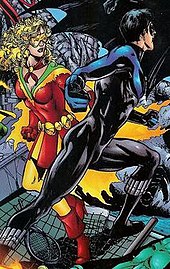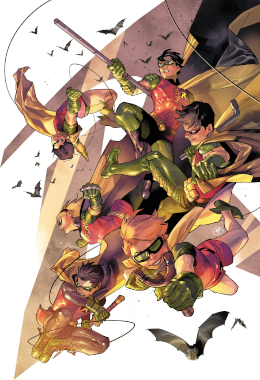
Robin is the alias of several superheroes appearing in American comic books published by DC Comics. The character was originally created by Bob Kane, Bill Finger, and Jerry Robinson, to serve as a junior counterpart and the sidekick to the superhero Batman. As a team, Batman and Robin have commonly been referred to as the Caped Crusaders and the Dynamic Duo. The character's first incarnation, Dick Grayson, debuted in Detective Comics #38. Conceived as a way to attract young readership, Robin garnered overwhelmingly positive critical reception, doubling the sales of the Batman titles. Robin's early adventures included Star Spangled Comics #65–130 (1947–1952), the character's first solo feature. He made regular appearances in Batman-related comic books and other DC Comics publications from 1940 through the early 1980s, until the character set aside the Robin identity and became the independent superhero Nightwing.
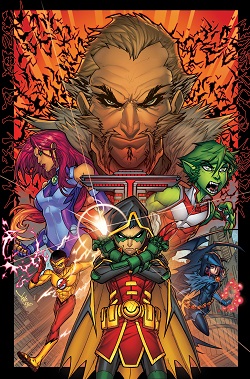
The Teen Titans are a superhero team appearing in American comic books published by DC Comics, frequently in eponymous monthly series. As the group's name indicates, the members are teenage superheroes, many of whom have acted as sidekicks to DC's premier superheroes in the Justice League. The original team later becomes known as the Titans when the members age out of their teenage years, while the Teen Titans name is continued by subsequent generations of young heroes. First appearing in 1964 in The Brave and the Bold #54, the team was formed by Kid Flash, Robin, and Aqualad (Garth) before adopting the name Teen Titans in issue 60 with the addition of Wonder Girl to their ranks.
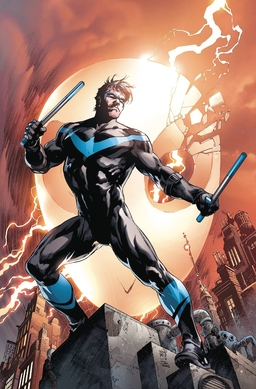
Nightwing is the name of several superheroes appearing in American comic books published by DC Comics. The most prominent is Dick Grayson, who takes the name when he leaves his role as Batman's partner and sidekick Robin in his adulthood.

Richard John "Dick" Grayson is a superhero appearing in American comic books published by DC Comics, commonly in association with Batman, Teen Titans and Justice League. Created by writer Bill Finger and artist Bob Kane, he first appeared in Detective Comics #38 in April 1940 as the original and most popular incarnation of Robin, Batman's crime-fighting partner. In Tales of the Teen Titans #44, the character, after becoming a young adult, retires his role as Robin and assumes the superhero persona of Nightwing. Grayson has donned the cape and cowl to replace Bruce Wayne as Batman. His most notable spell as Batman follows Bruce Wayne's supposed death in Final Crisis, and sees Grayson adopt Damian Wayne as his Robin.

Batgirl is the name of several fictional superheroines appearing in American comic books published by DC Comics, depicted as female counterparts and allies to the superhero Batman. The character Betty Kane was introduced into publication in 1961 by Bill Finger and Sheldon Moldoff as Bat-Girl, and was replaced in 1967 by Barbara Gordon, who became the iconic Batgirl. The character debuted in Detective Comics #359 by writer Gardner Fox and artist Carmine Infantino, introduced as the niece/adoptive daughter of police commissioner James Gordon.
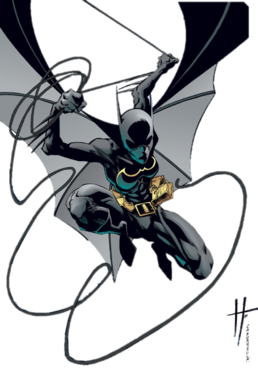
Cassandra Cain is a superheroine appearing in American comic books published by DC Comics, commonly in association with the superhero Batman. Created by Kelley Puckett and Damion Scott, Cassandra Cain first appeared in Batman #567. The character is one of several who have assumed the role of Batgirl. Over the years, she has also assumed the names of Black Bat and Orphan.

Renee Maria Montoya is a character appearing in media published by DC Entertainment. The character was created by Bruce Timm, Paul Dini and Mitch Brian for Batman: The Animated Series and was preemptively introduced into mainstream comics before the airing of her animated debut in 1992 in the DC Animated Universe (DCAU) series Batman: The Animated Series / The New Batman Adventures, voiced by Ingrid Oliu, and later Liane Schirmer. Originally conceived of as a heterosexual widow, she was later redeveloped as a lesbian and primary love interest of Kate Kane / Batwoman.

Caroline Keene "Carrie" Kelley is a superheroine from Frank Miller's graphic novels Batman: The Dark Knight Returns (1986) and its sequels Batman: The Dark Knight Strikes Again (2001–2002) and The Dark Knight III: The Master Race (2015–2017). She becomes the new Robin in The Dark Knight Returns when she saves Batman's life. Later in The Dark Knight Strikes Again, she adopts the identity Catgirl, and in The Dark Knight III: The Master Race, she adopts the identity Batwoman. She was the first full-time female Robin in the history of the Batman franchise, though Julie Madison had passed off as Robin for a brief time in a Bob Kane story published in Detective Comics #49 in March 1941.
Flamebird is the name used by six different fictional comic book characters who have appeared in books published by DC Comics, specifically from the Superman and Batman mythos.
Titans East is the name of several DC Comics superhero teams. The teams appear in the Teen Titans comic books and animated series. The comic book incarnation of Titans East first appeared in Teen Titans #18 (2005) during the "Titans Tomorrow" storyline, which is set in the future. A present-day incarnation appeared in Teen Titans #43 (2007), as a group of villains led by Deathstroke. Cyborg later assembled a new version of the team.
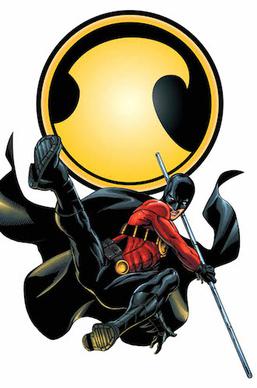
Red Robin is a name that has been used by several superheroes appearing in American comic books published by DC Comics. The identity was first used in the future timeline of the 1996 miniseries Kingdom Come, where a middle-aged Dick Grayson reclaims the Robin mantle and becomes Red Robin. His uniform is closer to Batman's in design than any previous Robin uniform. Red Robin then reappeared in promotional material for the DC Countdown miniseries; eventually, it was revealed that this Red Robin was not Dick Grayson, but rather Jason Todd, who appeared under the cape and cowl. This was the first time the identity had been used in the main DC Universe reality. During the "Scattered Pieces" tie-in to the "Batman R.I.P." storyline, Ulysses Armstrong briefly appears as Red Robin. In 2009, a new ongoing series was introduced titled Red Robin starring Tim Drake in the role. Drake was the third Robin before assuming the Red Robin persona.

Duela Dent is a fictional character in the DC Universe. She is a former member of the Suicide Squad, the Teen Titans and its counterpart, Titans East. Introduced under the alias of the Joker's Daughter, she has also used aliases: Catgirl the Catwoman's Daughter, Scarecrone the Scarecrow's Daughter, the Riddler's Daughter, the Penguin's Daughter, the Card Queen, and the Harlequin. She first appeared in Batman Family #6.
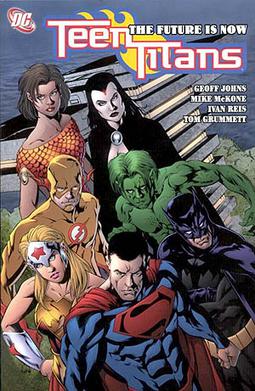
"Titans Tomorrow" is a storyline of a possible alternate future in the DC Comics Universe, from Teen Titans vol. 3 #17–19 (2005), by Geoff Johns and Mike McKone. The story arc has been collected as part of the Teen Titans: The Future is Now trade paperback.
Enigma is a name used by two supervillains published by DC Comics. The character first appeared in Teen Titans #38 and was created by Geoff Johns and Tony Daniel. A villain in Trinity has also used the name where he turns out to be the Anti-Matter Universe version of Riddler that formerly went by the name Quizmaster.

In addition to DC Comics books, the superhero Robin also appears in other media, such as films, television and radio. Dick Grayson, Jason Todd, Tim Drake, Stephanie Brown, and Damian Wayne are examples of the characters who use the name Robin.
This article is about the publication history of the DC Comics fictional character Dick Grayson, who has been portrayed in comic books alternatively as Robin, Nightwing, and Batman.

Batwoman is a superheroine appearing in American comic books published by DC Comics. Created by writers Greg Rucka, Geoff Johns, Grant Morrison, Mark Waid, and artist Alex Ross, Kane is a wealthy heiress who becomes inspired by the superhero Batman and chooses, like him, to put her wealth and resources toward a campaign to fight crime as a masked vigilante in her home of Gotham City as Batwoman.

Batwoman is a superheroine appearing in American comic books published by DC Comics. She is the first DC character to bear the name "Batwoman". She was created by writer Edmond Hamilton and artist Sheldon Moldoff under the direction of editor Jack Schiff, as part of an ongoing effort to expand Batman's cast of supporting characters. Batwoman began appearing in DC Comics stories beginning with Detective Comics #233 (1956), in which she was introduced as a love interest for Batman in order to combat the allegations of Batman's homosexuality arising from the controversial book Seduction of the Innocent (1954). When Julius Schwartz became editor of the Batman-related comic in 1964, he removed non-essential characters including Kathy Kane, Bat-Girl, Bat-Mite, and Ace the Bat-Hound. Later, the 1985 limited series Crisis on Infinite Earths retroactively established that Batwoman's existence was on an Earth separate from DC's main continuity.
Elizabeth Kane, also known as Alice and Red Alice, is a fictional character created by Greg Rucka and J. H. Williams III. Beginning as a supervillain, she first appeared in August 2009 in the comic book Detective Comics, published by DC Comics. Her relationship with her twin sister Kate Kane defines much of Batwoman's emotional life. During The New 52, it is established that Kate and Beth are cousins of Bruce Wayne, the alter-ego of the superhero Batman, through his mother Martha Wayne.
Batwoman is a name used by several characters of DC Comics, both in mainstream continuity and Elseworlds. The best known Batwomen are Kathy Kane and Kate Kane, while several original incarnations have appeared in adapted media.


